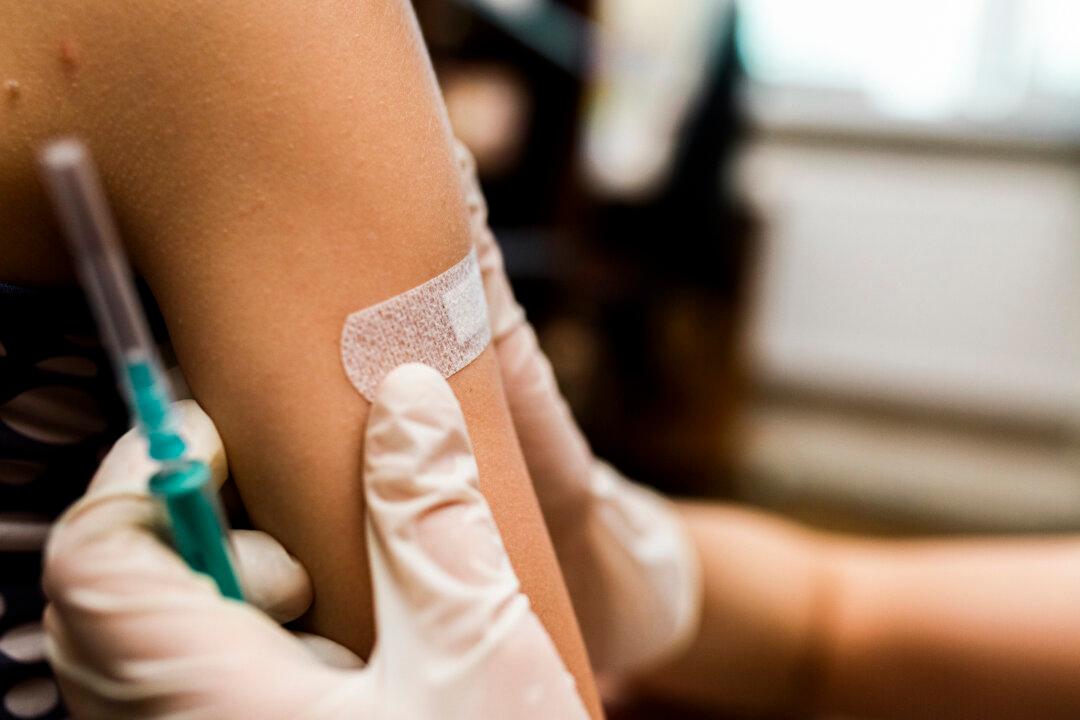Oral lesions may be a sign of reactivated viruses and fungal infections due to a more vulnerable immune system.

Multiple studies have reported oral and facial lesions occurring after COVID vaccinations and infections, with one review pointing out an observational study that found 70 percent to 100 percent of COVID-19 patients have reported some oral manifestations following infections.
Internal medicine physician Dr. Keith Berkowitz expressed that he is not surprised that patients are reporting ulcers, dry mouth, and various other orofacial manifestations.
“Any immune suppression can cause ulcers,” he told The Epoch Times, adding that oral lesions may be a sign of reactivated viruses and fungal infections due to a more vulnerable immune system.
Integrative medicine practitioner Dr. Yusuf Saleeby said that with the more recent COVID variants, he started noticing a change in the symptomology among his patients and also himself. Ulcers in and around the mouth became more prominent.
“Blistering, like lesions on the face, mouth, and ‘herpetic-like’ lesions in the mouth, lips, gums, and on the tongue,” Dr. Saleeby listed. Tooth and gum pain without the usual evidence of bacterial infections like an abscess has also been observed.
“Many infections present clinically in the oral cavity,” Dr. Nicola Cirillo, dentist and professor of dental medicine pathology and pharmacology at the University of Melbourne, told The Epoch Times.
Similar symptoms are observed in vaccinated people.
“Regarding vaccines, I do observe, occasionally, abnormalities in the head and neck region following vaccination—for example, enlarged cervical lymph nodes, swellings, and oral ulcerations,” said Dr. Cirillo.
A Wide Range of Oral Symptoms
Xerostomia
Also known as dry mouth, xerostomia is one of the most common symptoms reported in COVID-19 infections and an adverse event postvaccination.
Dry mouth can be both subjective—meaning the person feels that their mouth is dry—or it can be an objective indication that there is less saliva in the mouth.
Dr. Berkowitz said that, generally, dehydration is a likely cause of dry mouth since viral infections often cause fluid loss. However, dry mouth can also be caused by conditions such as diabetes and Sjogren’s syndrome, an autoimmune disease.
Dehydration is also a common problem for his long-COVID patients and those suffering from vaccine adverse events, Dr. Berkowitz observed. These patients often have trouble regulating fluid balance and need regular hydration therapy.
Mouth and Mucosal lesions
Ulcers and mouth lesions are common occurrences in infections. Studies have shown that the COVID-19 virus can infect the mouth, so some of these symptoms may be due to the virus infecting cells in the oral cavity.
The mucosa, which lines the inside of the oral cavity, has abundant ACE-2 receptors. The SARS-CoV-2 virus uses its surface spike proteins to bind to these receptors and cause infections. The COVID-19 vaccines also induce the body to produce spike proteins, which may similarly infect cells through the same receptors.
However, viruses and fungi may take advantage of the body during an infection and cause opportunistic infections, which can similarly cause painful lesions around and in the mouth. COVID-19 infections and the vaccine have been shown to cause a reactivation of oral herpes, which can cause blisters and cold sores around the mouth and inflamed gums.
Drs. Saleeby and Berkowitz believe that the cases in which vaccinated people report viral or fungal reactivation may be caused by immunosuppression. Candida is a common fungal infection reported in both COVID-19 infections and postvaccination. Patients may develop a painful white coating, known as thrush, on the tongue and other interior surfaces of the mouth. Usually, this white coating can be wiped off, leaving behind a red surface.
Swollen and Inflamed Tongue
COVID-19 infections have been known to cause tongue swelling and loss of taste buds, causing the tongue to look patchy or pink and glossy. This has also been reported as an adverse reaction postvaccine.
An Australian case study reported a 60-year-old woman who developed painful tongue inflammation and dry mouth three days following her first Pfizer vaccine.
“After partial interval improvement, her symptoms progressively worsened after a second vaccination and third booster vaccination,” the authors wrote. During this time, the patient lost nearly 20 pounds due to difficulty eating.
The patient was treated with oral corticosteroids, which helped to reduce the inflammation, and within weeks, her problems were resolved.
Gum Symptoms
Studies have extensively linked gum diseases with COVID-19 infection. People with periodontal disease are more at risk of having a poor prognosis with COVID-19 infection. Likewise, COVID may worsen periodontal disease.
Burning and bleeding gums is a common adverse event reported following COVID-19 vaccinations. One study found that it was the most commonly reported oral adverse event among females.
A Korean study reported a case in an 81-year-old female who reported pain in her tongue and left palate three hours after taking her Pfizer vaccine.
At the appointment, her doctor noticed the area where she reported pain had ulceration and a decline in gum tissue, exposing her root. She was treated with the steroid dexamethasone, nystatin syrup (an antifungal), and chlorhexidine gargle (an antiseptic). A week later, her tongue pain had alleviated, and there were also signs of gum regeneration, though some swelling and redness remained.
Transient and Often Responds Well to Treatment
Most case studies have reported recovery weeks and months after treatments are prescribed.
Dr. Cirillo, one of the first to discuss the link between facial palsy and COVID-19 vaccines, said that “most adverse reactions are transient and self-limiting … some may be serious or life-threatening.”
Since even transient conditions may extend for months or years, Dr. Cirillo said, “it is important to inform vaccine recipients about these possible consequences.”
In a letter to the editor of the journal Oral Diseases, Indian dentists recommended that patients with oral lesions following COVID-19 vaccinations take dexamethasone, a steroid used to reduce swelling and inflammation, along with an antiviral (acyclovir), an antifungal (nystatin syrup), and an antiseptic (chlorhexidine gargle).
If the patient has oral candidiasis, the analgesic clonazepam and fluconazole syrup are recommended.
“All cases were resolved within a varying period of 1 week to 1 month, while some even took up to 2 months. These treatments significantly relieved all symptoms, including tongue pain and ulcerative lesion,” the authors wrote.
Dr. Saleeby has found success treating patients with ivermectin and hydroxychloroquine, which have been shown to help clear the COVID-19 virus.
For patients with herpes skin reactions, he also adds the antiviral acyclovir, monolaurin, and L-lysine. Monolaurin is a chemical naturally occurring in coconut milk and human breast milk with strong antibacterial and antiviral properties. L-lysine is an essential amino acid needed to produce all amino acids in the body. It has also been shown to help with the recovery of cold sores
